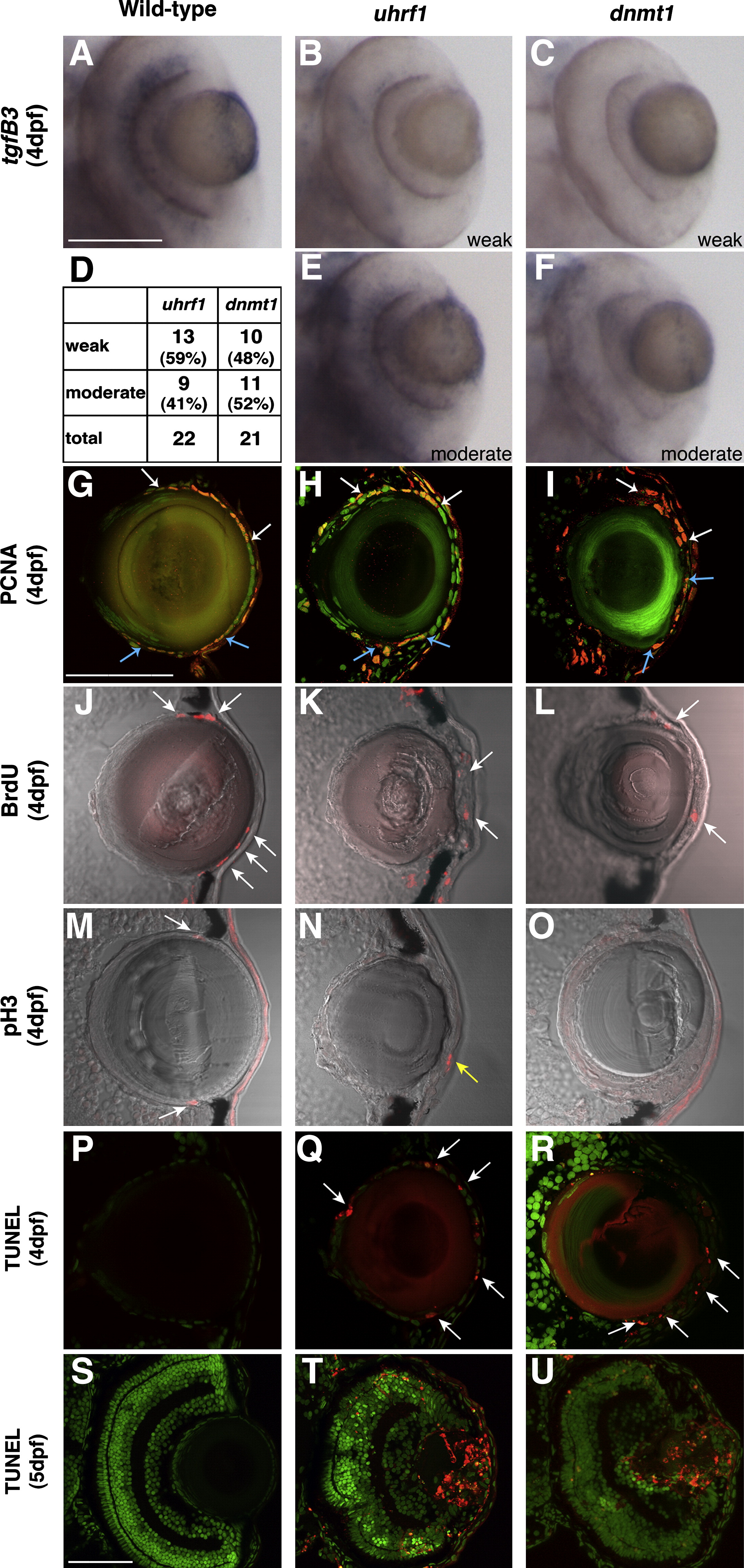Fig. 6 Lens epithelium gene expression, cell proliferation, and apoptosis is altered in uhrf1 and dnmt1 mutant lenses. (A–C,E,F) Whole mount dorsal images of the retina and lens of tgfB3 antisense in situ hybridizations on wild-type (A), uhrf1 (B,E) and dnmt1 (C,F) mutant embryos at 4 dpf. (A) Wild-type lenses showed strong staining for tgfB3, while staining in mutant lenses was classified as either weak (B,C) or moderate (E,F) (summarized in the table (D)). (G–I) Cryosections from 4 dpf embryos immunostained for PCNA (red). PCNA-positive cells are present in the lens epithelium of phenotypically wild-type (G) embryos as well as uhrf1 (H) and dnmt1 (I) mutants. In each panel, arrows of the same color indicate the dorsal and ventral proliferative zones within the lens epithelium, as defined by PCNA staining. (J–L) Cryosections through 4 dpf phenotypically wild-type (J), uhrf1 (K), or dnmt1 (L) lenses stained for incorporation of BrdU (applied between 96 and 98 hpf). White arrows point to lens cells which have incorporated BrdU. Fewer BrdU-incorporating cells are labeled in the uhrf1 and dnmt1 mutant lenses than in wild-type sibling lenses, and mutant cells labeled with BrdU are not positioned exclusively in the lateral epithelium as they are in the wild-type lens. (M–O) Phosphohistone H3 (pH3) immunostaining of 4 dpf (M) phenotypically wild-type, (N) uhrf1 mutant and (O) dnmt1 mutant embryos. White arrows in panel M show two cells in the wild-type lens epithelium stained positively for pH3. (N,O) No pH3 positive cells are observed in mutant lens epithelium. The yellow arrow in (N) indicates a pH3 positive cell in the cornea. Some sections have diffuse background staining in the cornea which is not localized to nuclei. (P–U) TUNEL immunostaining (red) of 4 dpf (P–R) and 5 dpf (S–U) phenotypically wild-type (P,S), uhrf1 (Q,T) and dnmt1 (R,U) mutant cryosections. No apoptotic cells are observed in the lens of wild-type embryos at 4 dpf (P), but numerous TUNEL-positive cells are observed in the still-nucleated epithelial and early fiber regions of the uhrf1 and dnmt1 mutant lenses (white arrows in Q, R). At 5 dpf, TUNEL-positive cells are rare in the wild-type eye (S), however, uhrf1 and dnmt1 mutant lenses contain numerous TUNEL-positive cells in the lens, and some in the cornea and retina (T,U). In all 4 dpf panels, mild mutants were selected for analysis. Sections in panels A–C and J–O are counter-stained with Sytox-Green (green). Anterior is to the right in all panels. Scale bars are 100 μm in A–C and E–F, 70 μm in G–R, and 80 μm in S–O.
Reprinted from Developmental Biology, 350(1), Tittle, R.K., Sze, R., Ng, A., Nuckels, R.J., Swartz, M.E., Anderson, R.M., Bosch, J., Stainier, D.Y., Eberhart, J.K., and Gross, J.M., Uhrf1 and Dnmt1 are required for development and maintenance of the zebrafish lens, 50-63, Copyright (2011) with permission from Elsevier. Full text @ Dev. Biol.

